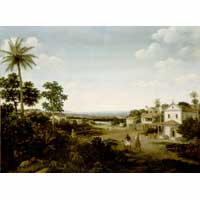On this day in 1637 Johan Maurits, scion of the Nassau Orange dynasty and the recently appointed Governor of the Dutch colony in north-east Brazil, arrived at the Brazilian port of Recife on a mission of conquest and consolidation. This week’s picture, a depiction of a scene in Brazil by Frans Post, an artist who accompanied Maurits on his travels It is owned by the Rijksmuseum but is currently on long-term loan to the National Gallery in London.
Maurits’s aim was to wrest control of as much of the country as possible from its Portuguese rulers. He wasted no time in capturing Porto Calvo, which he attacked with a force of 3000 Dutch soldiers, 1000 sailors and 1000 American Indians. He sacked the small town of Penedo, where he built a fort, Fort Maurits, and took possession of a plantation colony. He needed slaves to carry out the back-breaking work of cultivating and harvesting sugar cane, but Holland’s enemies, the Portuguese, still controlled the slave trade from the great fortress of Sao Jorge da Mina on the Gold Coast (present-day Ghana). Maurits sent an expeditionary force to capture it, his soldiers prevailed, and within a few years the Dutch had gained control – albeit a tenuous and, as it proved, short-lived control – over approximately half of Brazil.
Maurits’s aim was to wrest control of as much of the country as possible from its Portuguese rulers. He wasted no time in capturing Porto Calvo, which he attacked with a force of 3000 Dutch soldiers, 1000 sailors and 1000 American Indians. He sacked the small town of Penedo, where he built a fort, Fort Maurits, and took possession of a plantation colony. He needed slaves to carry out the back-breaking work of cultivating and harvesting sugar cane, but Holland’s enemies, the Portuguese, still controlled the slave trade from the great fortress of Sao Jorge da Mina on the Gold Coast (present-day Ghana). Maurits sent an expeditionary force to capture it, his soldiers prevailed, and within a few years the Dutch had gained control – albeit a tenuous and, as it proved, short-lived control – over approximately half of Brazil.
Johan Maurits was a highly educated man, a connoisseur of art who was also interested in furthering the advance of scientific knowledge. His principal legacy today is the Mauritshuis in the Hague, once his residence and now one of the world’s most beautiful museums. During the seven years that he was in Latin America, he governed Brazil as an enlightened monarch, devoting himself with great enthusiasm to a variety of civic building projects. He also built a palace for himself,...


